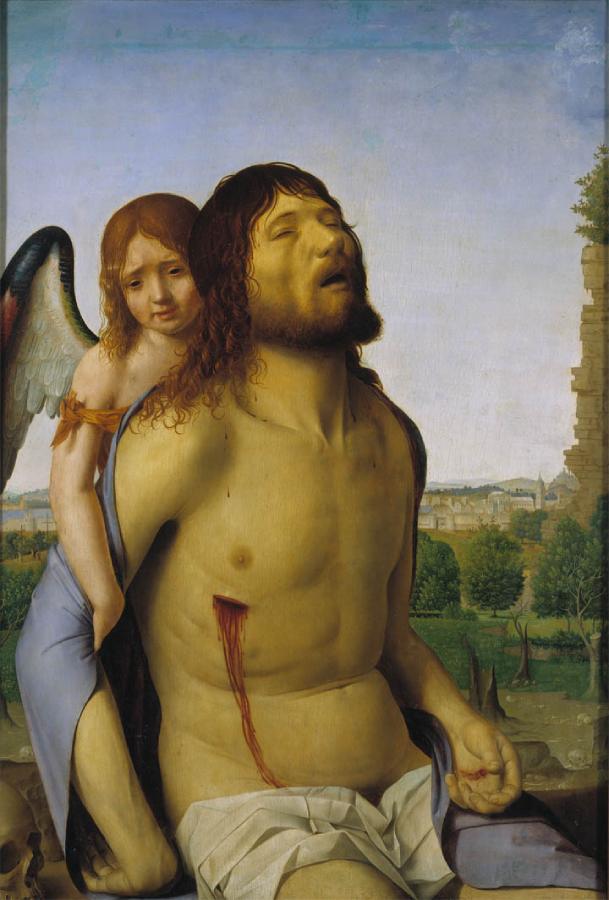Antonello da Messina (c.1430-1479)
Cristo morto sostenuto da un angelo (Dead Christ Supported by an Angel)
1475–1476
Mixed method on panel, 74 x 51 cm
Museo del Prado, Madrid
Antonello da Messina was trained in Naples, the Italian city where the influence of Flemish painting was greatest. He later worked in Sicily and mainland Italy. In 1475, he travelled to Venice. Although he painted this work after returning to Messina –the city visible in the background– it would have been inconceivable without the Venetian painter Giovanni Bellini, whose versions of the Pietà provided Antonello with a compositional (Christ in the foreground) and iconographic (the inclusion of angels) reference point. Antonello’s highly virtuosic work combines meticulous brushstrokes of Nordic origin –perceptible in the landscape and Christ’s hair– with excellent treatment of the anatomy and care towards the volume and perspective which are clearly southern in origin.
Manuela Sáez (2009: 26–32) brought to light the first known reference of Antonello da Messina’s dead Christ: it was found in an inventory of paintings compiled in 1633 belonging to the 7th Countess of Lemos, Doña Catalina de la Cerda y Sandoval. The inventory includes ‘A painting of the dead Christ in the tomb with an Angel weeping. Original of Durelo [sic] with its moulding and garnished box with many stones presented to her by Cardinal Aldrobandino [sic]’. When Cardinal Aldobrandini decided to present the Countess of Lemos with Dead Christ Supported by an Angel as an original by Durero –even though its attribution was doubtful at best– this decision was partly due to the scarcity of the artist’s works but also should be understood in the context of the Spanish court’s appreciation for Flemish and Northern European painting since the reign of Philip II, King of Spain.
The painting must have remained in a private oratory or in the Countess’s own bedroom in the convent of the Concepción de Monforte de Lemos. She and her husband founded the convent, and it was there that she professed her vows after becoming a widow until her death on 14 March 1648. After Catalina’s death, the painting remained in the convent in Monforte until the Napoleonic invasion of 1809, when there was an initial attack on the town in January followed by two more on 24 April and 4 June. These were accompanied by looting and pillaging which affected all of its important buildings. In order to secure the precious liturgical objects and ornaments during the invasion, the nuns of the monastery of the Concepción distributed them amongst private houses, most probably turning to the Yáñez Rivadeneira family in the Pazo de Molinos de Antero due to their high social reputation and the solidity and security of the building. Indeed, various documents demonstrate the close relationship and trust that existed between the Yáñez family and the convent of the Concepción in the late-18th and early 19th centuries.
Manuel Antero Yáñez’s will, dated 9 September 1862, includes an appendix of five handwritten folios containing an inventory of ‘pictures and oil paintings’ that specifies which works went to each of his sons. The third folio states Don Matías’s share, with the following entry: ‘The Redeemer descended from the Cross in the arms of an Angel at the foot of the sepulchre; new painting in veneered wood, one rod high and three-quarters wide’. The measurements coincide with Antonello’s Dead Christ in the Museo del Prado. It must be taken into account that in the 19th century a Spanish rod was typically equivalent to 0.85 metres. Furthermore, in the left-hand margin of the folio next to the description of the painting, the following has been noted: ‘In the Museo del Prado since 1965’.
The reference to the ‘garnished box with many stones’ in the Countess of Lemos’s 1633 inventory of paintings disappears from Manuel Antero’s inventory of 1862. It is replaced by a ‘new veneered wooden picture’. This fact suggests that the precious or semi-precious stones that constituted the original frame’s ornamentation were the initial sought-after objects of the 1809 looting rather than the painting that they framed.
Years after the death of Manuel Antero Yáñez, his son Matías sold the panel to Rosa Mendiluce, a resident of Bilbao. This is made evident by a set of three letters that Juan Miguel Albisu –Rosa’s grandson and heir to the panel– sent to the Museo del Prado following the purchase of the painting in 1965, the year that the painting entered the Museum. It was then attributed to Cima da Conegliano. However, this was corrected shortly afterwards to the present attribution thanks to the research of the former deputy director of the Museo del Prado, Xavier de Salas (1967: 125–138), who meticulously compared the recent acquisition with Messina’s work in English and French museums.
Ordás Díaz, Pablo, De Sicilia al Prado: el largo viaje del Cristo Muerto sostenido por un ángel de Antonello de Messina. Boletín del Museo del Prado, 2019-2021, p.11-22.
